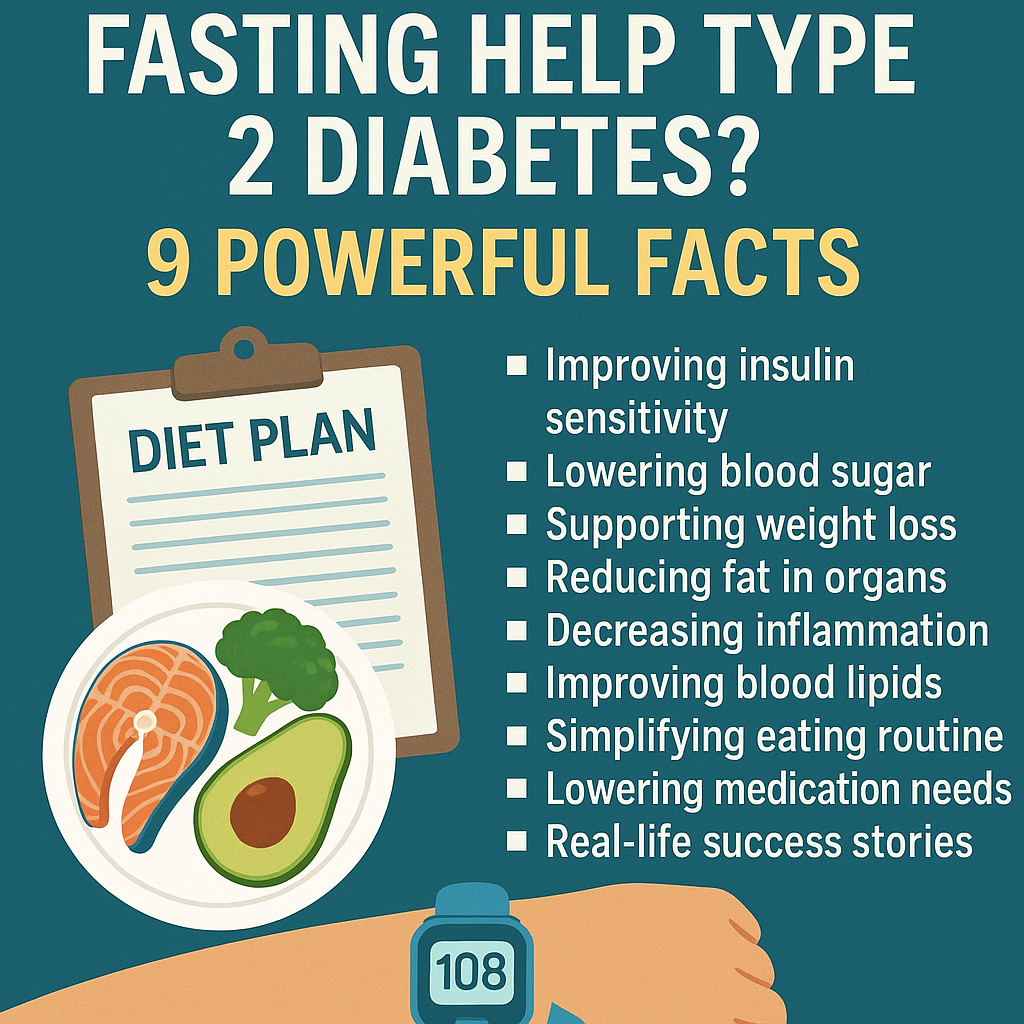
⚠️ Affiliate Disclaimer: This post may contain affiliate links, which means I may earn a small commission — at no extra cost to you — if you make a purchase through one of these links. I only recommend products or services I genuinely trust and believe can provide value. Thank you for supporting My Medical Muse!
Can Intermittent Fasting Help Type 2 Diabetes? 9 Powerful Facts
Can Intermittent Fasting Help Type 2 Diabetes? Benefits, Risks, and How to Do It Safely
Imagine regaining control over your blood sugar, needing fewer medications, and feeling more energetic without having to count every calorie or swear off your favorite foods. That is the promise you’ll often hear about intermittent fasting but for people living with Type 2 diabetes, the question is, can changing when you eat really make that much of a difference?The science is promising but it is not a free pass. When done wrong, intermittent fasting can be risky, when done right, it could become one of the most powerful tools in your diabetes management toolkit.
This guide covers everything you need to know, the benefits, the risks, the science, the meal timing strategies, what research says, and real-life examples.
What Exactly Is Intermittent Fasting?
Intermittent fasting isn’t about what you eat, it’s about when you eat. It involves alternating between periods of eating and fasting.The idea is simple, give your body extended breaks from processing food so it can switch from burning glucose (sugar) to burning fat for fuel.
Popular Intermittent Fasting Styles
- 16/8 Method: Fast for 16 hours, eat in an 8-hour window (e.g., 10am to 6 pm)
- 5:2 Diet: Eat normally 5 days, limit to 500-600 calories on 2 nonconsecutive days
- Alternate-Day Fasting: Eat normally one day, eat very little or nothing the next
- Early Time-Restricted Feeding (eTRF): Eat all meals earlier in the day (e.g., 7am -3pm)
The Science: How Fasting Affects Blood Sugar
To understand why intermittent fasting might help with Type 2 diabetes, let’s walk through what happens inside your body during a fast:
0-4 hours after eating:
- Blood sugar rises from your last meal.
- Insulin is released to help store glucose in muscles and the liver.
4-8 hours:
- Blood sugar returns to baseline.
- The body starts tapping into stored glycogen in the liver.
8-12 hours:
- Glycogen stores begin to deplete.
- The body switches to burning fat for energy, reducing reliance on glucose.
12+ hours:
- Insulin levels drop significantly.
- Cells become more sensitive to insulin’s signal.
The pancreas gets a “rest” from producing large amounts of insulin. For people with Type 2 diabetes, this insulin sensitivity boost can mean lower blood sugar readings and reduced inflammation over time.
How Intermittent Fasting Might Help Type 2 Diabetes
- Improving Insulin Sensitivity: Think of insulin as a key and your cells as locks. In insulin resistance, the locks are rusty. Fasting helps oil those locks so the key works better. A 2018 Cell Metabolism study showed that early time-restricted feeding improved insulin sensitivity and blood pressure in men with prediabetes even without weight loss.
- Lowering Fasting Blood Sugar: Studies show a 3-6% drop in fasting glucose among people with high baseline levels, small but clinically meaningful.
- Reducing Fat in the Liver and Pancreas: Excess fat in these organs worsens insulin resistance. Fasting helps burn stored fat, reducing the “fatty traffic jam” in these critical areas.
- Supporting Weight Loss: Even modest weight loss (5-10% of body weight) can improve blood sugar control. Intermittent fasting can create a calorie deficit without strict dieting.
- Lowering Inflammation: High blood sugar triggers chronic inflammation, which worsens complications. Intermittent fasting reduces inflammatory markers like CRP.
- Improving Blood Lipids: Lower triglycerides, higher HDL cholesterol, a big plus since heart disease risk is higher with diabetes.
What the Research Says
- 2018, BMJ Case Reports: Three men with Type 2 diabetes used alternate-day fasting. Within months, they stopped insulin and reduced other meds.
- 2021, JAMA Network Open: 8-hour eating windows improved glycemic control and reduced weight in adults with Type 2 diabetes without reducing total calories.
- 2019, Nutrients: Review concluded intermittent fasting is promising for blood sugar management but must be individualized.
- 2022, University of Illinois Chicago: Participants improved insulin sensitivity after 4 weeks of 16/8 fasting without weight loss, showing benefits beyond calorie restriction.
Benefits of Intermittent Fasting for Type 2 Diabetes
- Better blood sugar control (fewer spikes & crashes)
- Weight loss without food obsession
- Lower insulin resistance
- Reduced medication needs (doctor-supervised)
- Improved cholesterol & triglycerides
- Simplified eating routine
Risks and Drawbacks You Need to Know
- Hypoglycemia (Low Blood Sugar): If you’re on insulin or sulfonylureas, fasting can cause dangerous drops.
- Nutrient Deficiencies: Skipping meals without planning leads to missed nutrients.
- Overeating During Eating Windows: Bingeing cancels out benefits and spikes blood sugar.
- Digestive Discomfort: Bloating or constipation can happen when routines change suddenly.
- Not Suitable for Everyone: Unsafe for pregnant women, people with eating disorders, or advanced diabetes complications.
Tips for Trying Intermittent Fasting Safely
- Consult your doctor first
- Start small, try 12/12 before 16/8
- Stay hydrated
- Eat nutrient-dense foods in your window
- Check blood sugar often in the first weeks
- Adjust medications if needed with your doctor’s guidance.
What to Eat During Eating Windows
Focus on low glycemic index, nutrient-rich foods:
- Protein: fish, chicken, tofu, eggs
- Healthy fats: avocado, olive oil, nuts
- Complex carbs: oats, quinoa, sweet potato
- Vegetables: spinach, broccoli, peppers
- Fruits: berries, apples, citrus
Types of Intermittent Fasting for Type 2 Diabetes, Pros, Cons & Suitability
- 16/8 Method: It is easy, flexible, works well for most. Morning lows are possible, evening carbs may spike sugars
- Early Time-Restricted Feeding (eTRF): It has strong research support, reduces night snacking.However, it is socially inconvenient
- 5:2 Diet: It is flexible, effective for weight loss but fasting days are tough for medicated diabetics.
- Alternate-Day Fasting: Rapid weight loss potential, but it has a high hypoglycemia risk.
- OMAD (one meal a day): It is simple to follow However, nutrient gaps, large glucose spikes are common with this method. It is not so suitable or sustainable in the long run.
16/8 and eTRF are the safest starting points for most people.
Frequently Asked Questions
- Coffee or tea during fast?: Yes, unsweetened only.
- Low blood sugar?: Break fast immediately with fast carbs.
- Will fasting cause DKA?: Rare in Type 2, but watch for symptoms.
- Can I take meds while fasting?: Yes, but dosing may need changes.
- How soon will I see results?: 1 week for glucose, 8-12 weeks for HbA1c.
- Will I lose muscle?: Not if protein and resistance training are adequate.
- Can I work out fasting?: Yes, start light, monitor sugars.
- Very hungry during fast?: Water, tea, coffee help.
- Is intermittent fasting safe long-term?: Yes, with monitoring.
- Do I have to fast daily?: No, even 3-4 days/week can help.
Real-Life Success Stories
- John’s 16/8 Journey: Started intermittent fasting with a fasting blood glucose of 160mg/dl which improved to 120 mg/dL. He also losed 13 lbs in 3 months, resulting in cutting metformin dose by 50%.
- Maria’s eTRF Switch: Her starting HbA1c was 7.4%, which improved to 6.8% in just 6 weeks of intermittent fasting. She losed 4.5kg in the same period therefore increasing her morning energy level, reducing easy tiredness.
- Ahmed’s 5:2 Diet: At the start of her intermittent fasting journey, her HbA1c was 8.1%, it reduced to 7.0% in 4 months, with positive impact in lowering his high blood pressure and help in giving him more control over his eating habits.
The Bottom Line
Intermittent fasting isn’t a cure, but it can be a game-changer for Type 2 diabetes when done safely. Pick a method that suits your lifestyle, work with your doctor, and focus on nutrient-rich meals in your eating window.
👩⚕️ Need Personalized Health Advice?
Get expert guidance tailored to your unique health concerns through MuseCare Consult. Our licensed doctors are here to help you understand your symptoms, medications, and lab results—confidentially and affordably.
👉 Book a MuseCare Consult NowRelated Post You Might Like:
- 10 Sneaky Symptoms of Prediabetes in Women Over 40 You Can’t Ignore
- Aspirin After Minor Stroke: 7 Powerful Facts You Must Know
- Cold Feet and Tingling? 7 Easy At-Home Tests for Nerve Damage
- Sleep Better with Neuropathy: 14 Doctor-Approved Tips
- Cold Feet from Neuropathy or Poor Circulation? 7 Shocking Differences You Need to Know


